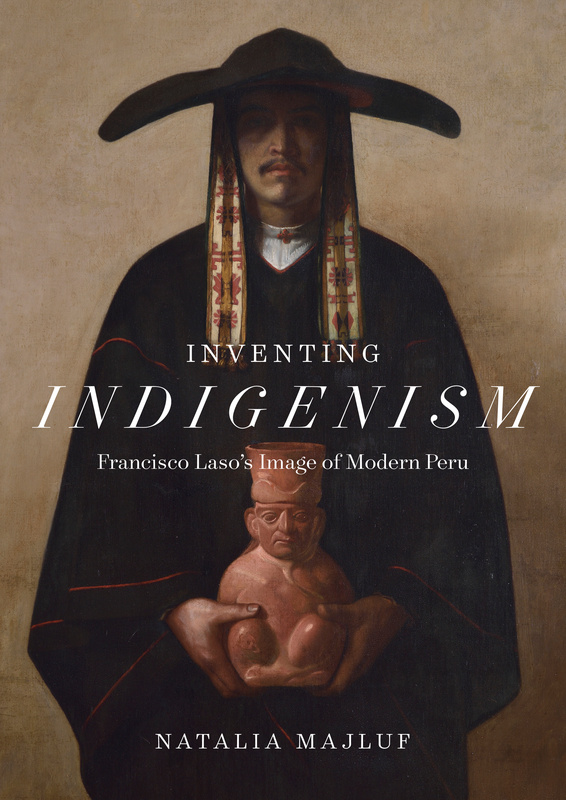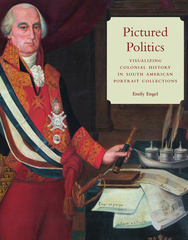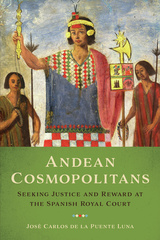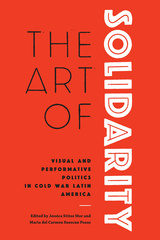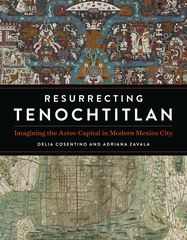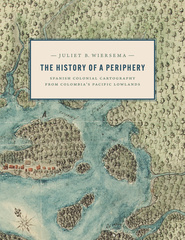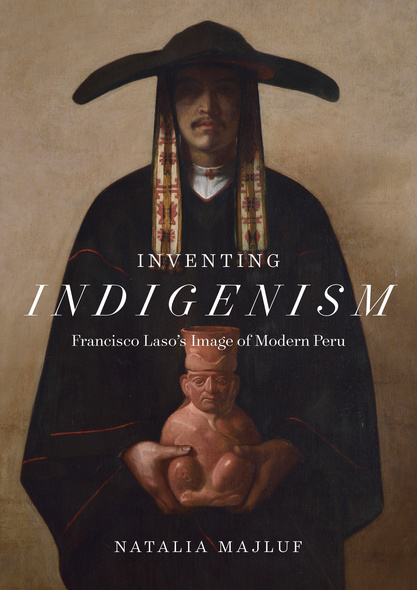
Inventing Indigenism
Francisco Laso's Image of Modern Peru
2023 ALAA Book Award, Association for Latin American Art/Arvey Foundation
A fascinating account of the modern reinvention of the image of the Indian in nineteenth-century literature and visual culture, seen through the work of Peruvian painter Francisco Laso.
One of the outstanding painters of the nineteenth century, Francisco Laso (1823–1869) set out to give visual form to modern Peru. His solemn and still paintings of indigenous subjects were part of a larger project, spurred by writers and intellectuals actively crafting a nation in the aftermath of independence from Spain. In this book, at once an innovative account of modern indigenism and the first major monograph on Laso, Natalia Majluf explores the rise of the image of the Indian in literature and visual culture. Reading Laso’s works through a broad range of sources, Majluf traces a decisive break in a long history of representations of indigenous peoples that began with the Spanish conquest. She ties this transformation to the modern concept of culture, which redefined both the artistic field and the notion of indigeneity. As an abstraction produced through indigenist discourse, an icon of authenticity, and a densely racialized cultural construct, the Indian would emerge as a central symbol of modern Andean nationalisms.
Inventing Indigenism brings the work and influence of this extraordinary painter to the forefront as it offers a broad perspective on the dynamics of art and visual culture in nineteenth-century Latin America.
Inventing Indigenism winds through the dense and entangled evolution of nationalist concepts and emblematic racial envisionings of the Peruvian Indian, Indigeneity, and Indigenism...[Majluf's] narratives are compelling...and advance important information and insights through intricate and multifaceted analyses that view the notion of nation as unstable...Inventing Indigenism is a multilayered examination of nation building. At the same time, the book asks all readers to consider how racial stereotypes and perspectives of the past, embedded in complex political and cultural viewpoints, continue as present day unfixed social constructs that still function in assessing the identity of self as well as others.
[An] engagingly written and meticulously researched book…Among the many high-quality illustrations, the dark symmetry of the 'Inhabitant' amply depicts the dignity of Indian suffering, while a ceramic figurine, cupped reverentially in his hands, references the 'violent stifling' of Inca society and the resultant sense of loss that Laso believed to be imprinted in Indian memory. That is one message of this book. Its other considerable achievement is to have begun the restoration of the nineteenth century to its rightful place in the cultural history of both Peru and Latin America.
A groundbreaking study...The book, like a fine exhibition, is expertly curated to guide the reader through a fascinating exposition about the nineteenth-century origins of modern pictorial indigenism in Peru as featured in Laso’s work...This compelling and exquisite book is the product of a dedicated and masterful Art Historian. It is a book that should be required reading for every Latin American scholar conducting research on the complexities of colonial and republican legacies of Peruvian indigenism and identity politics. Natalia Majful’s contextual analysis and insightful expertise has rendered a valuable and most welcome scholarly contribution to both academic and nonacademic enthusiasts of Latin American art.
Majluf’s study is a welcome and much-needed addition...Her use of Francisco Laso’s iconic painting Inhabitant of the Cordilleras of Peru (1855) as a point of departure for the exploration of multiple discourses on Andean indigeneity in nineteenth-century Peru is an inspired strategic move. It reveals an artist who understood his world and the processes at work as Peru struggled to define itself...[Majluf's] study stands as a model for research in nineteenth-century Latin American art history, and her book should be of great interest to a range of audiences, given its nuanced exploration of the intersections between indigeneity, nationalist politics, and visual culture.
Inventing Indigenism is proof of the high-quality studies that can be produced through deep levels of understanding of images and visuality across time, space, and disciplines. One painting and its broad signification brings forth current discussions on postcolonial studies and transnationality; it displaces the perpetuation of the colonial as a cultural construct and deeply engages with the possibilities of revisiting and rewriting the past. The book is complex and at the same time simple, as it comes across as an urgent study of not only art and art making but also race and representation in Latin America. It is a strong, challenging, and yet empathic study, necessary for contemporary times as a very smart model of what art history can and must urgently do.
It is impossible to summarize with any justice the richness and sophistication of the analysis that Majluf carries out in the book.Es imposible de resumir con justicia. A continuación, presentaré solo algunos elementos de sus capítulos centrales y luego estableceré un breve diálogo con el libro.
By bringing the work of Francsico Laso to the forefront of art history, Inventing Indigenism is highly valuable for research and teaching in Latin American Studies, especially at the graduate level. Although the study focuses specifically on the case of Laso and Peru, its many lessons about the ways in which el Indio gained a privileged status in an articulation of national discourse can be fruitfully applied to a broader Latin American and Global South context.
As an examination of race, identity, visual culture, literature, and politics in nineteenth-century Peru, Inventing Indigenism is an important addition to the literature on Latin American art, and will be a pioneering text in the field, setting the stage for future scholarship on the region.
Natalia Majluf has gifted us with a brilliant and innovative study of one of the nineteenth century’s most original artists: Francisco Laso. As the peasant and worker were key subjects for Courbet and Millet in France, the Indian and race were Laso’s primary focus in Peru. Majluf carefully combines analysis of Laso’s hauntingly beautiful paintings, such as the Inhabitant of the Cordilleras of Peru, with the formation of Peru’s national identity and the concept of the 'Indian'--later to become ‘Indigenism.’
Inventing Indigenism adeptly explores the evolving discourse of modern indigenism in nineteenth-century Peru and intelligently asserts that Francisco Laso’s majestic Inhabitant of the Cordilleras of Peru emerges out of cultural discourses of modernity. Majluf argues that Laso’s Inhabitant is the result of an intellectual project that constructs the first representation of a modern Indian, an idealized symbol of the Indian as nation. As a Creole elite with an upbringing in political and intellectual circles, Laso was invested in building a collective national imaginary through his paintings of indigenous people and traditions. For students and scholars alike, this book markedly advances the scholarship on nineteenth-century Latin American art.
- A Note on the Text
- Preface
- Introduction
- Francisco Laso: A Republican Biography
- Indigenism’s National Imaginaries
- From Society, into Painting, and Back
- Precedents: A Short History of the Indian—Concept and Image
- 1. The Indian: Image of the Nation
- A Local Antiquity
- Idealization
- Painting’s Critical Function
- Gonzalo Pizarro: The Scene of Conquest and the Spanish Legacy
- The Indian as Cultural Concept
- Creole Failures
- The Indian as Allegory and Symbol
- 2. The Scene of Approximation
- The Country of Melancholy: The Creole Invention of the Andean World
- Melancholy’s Modern Transformations
- An Andean Legend: The Burial of the Priest
- The Inscrutable Indian
- The Rhetoric of Approximation: The Pascana Series
- A Critical Fortune of Racial Readings
- Reading Race: The Role of the Viewer
- The Construction of the Indian Image
- 3. Picturing Race
- Impossible Images
- The Elusive Indian
- Epilogue: Personal Narratives, Public Images
- Chronology
- Notes
- Bibliography
- Index

